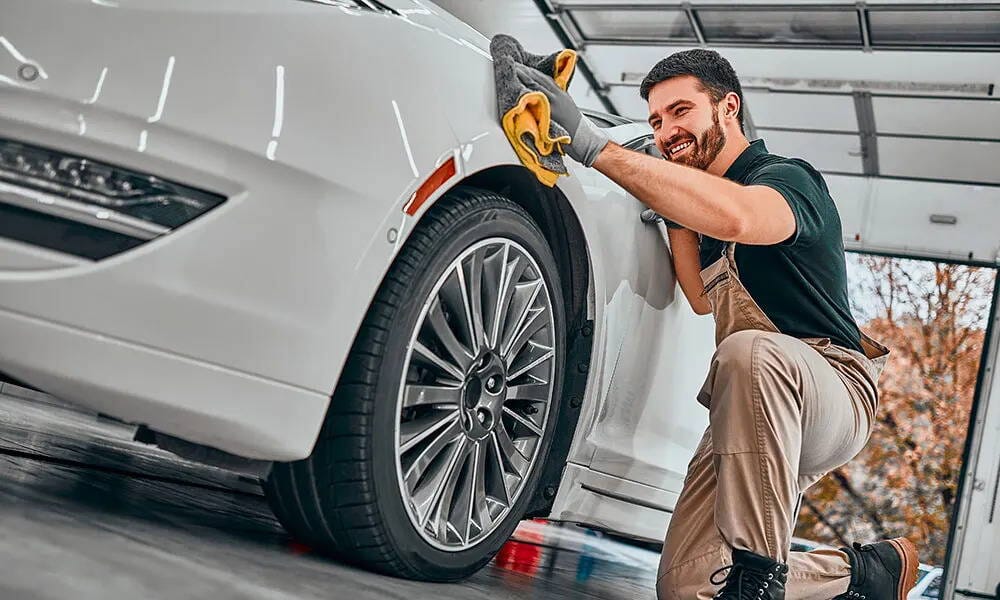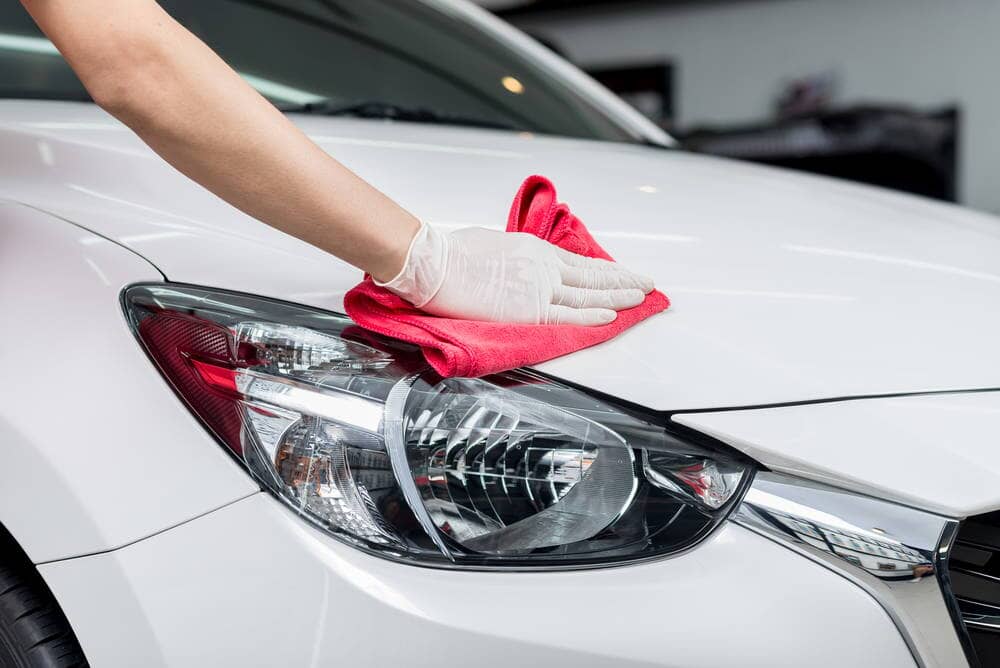When we’re talking about paint protection products, the detailing industry has a plethora of options that fit every budget and offer various levels of protection, durability, and aesthetic enhancement.
There are waxes, both natural and synthetic, sealants, ceramic coatings, and several hybrid products that combine different features and properties.
★★★★★ "Saw this being promoted on a big YouTube channel and thought why not try it. Was a bit skeptical but WOW. Super easy to apply and car is shining. Water still pelts off 3 weeks later! Gonna ditch the wax and will continue to use." - Josh S.
Out of this huge variety, the paint sealant rises as the golden mean of paint protection - cheap, easy to use, decent shielding, and acceptable longevity.
But perhaps we’re getting ahead of ourselves...
What is a Paint Sealant?
Paint sealants are synthetic chemical products that are applied on top of the clear coat of your vehicle. They form a sacrificial barrier that protects the paint from dirt, brake dust, and other contamination from the road. Paint sealants also guard against UV exposure, moisture, and acidic substances, such as bird droppings, tree sap, and bug splatter. This extra layer is hydrophobic, meaning it repels water and prevents contamination from settling on the body panels. As a result, the paint remains cleaner for longer and is easier to wash with less aggressive cleaning products.
All these properties are chemically engineered into the formulation of the paint sealant, which can vastly differ between manufacturers and has no standardized content.
The detailing industry is guilty of overusing terms like “polymers” and “resins” to describe the contents and properties of paint sealants...and other detailing products. In reality, these terms are so broad, they are practically meaningless.
What is a Polymer?
A polymer is a large molecule (macromolecule) that’s composed of smaller, endlessly repeating identical molecules, called monomers. You can best imagine it as a huge chain of identical links.
Most plastics that we’d be aware of are synthetic polymers like polyethylene (PE), polystyrene (PS), polypropylene (PP), polytetrafluoroethylene (PTFE, or Teflon as branded by DuPont). PVC, Nylon, Bakelite, and silicone are all polymers. In fact, modern clear coats, which are most commonly made from polyurethane or acrylic, are also polymers.
Resins are super-viscous liquids or amorphous solids that can be both natural and man-made. They are also considered polymers. Besides that, polymers can be found in naturally occurring substances, like cellulose, tree-rubber, proteins, and even DNA.
All these chemical compounds offer vastly different properties, so just saying some detailing products contain polymers is no more descriptive than saying you have alloy wheels —— steel being an alloy of iron and carbon.
Here’s a simple fact: We don’t know exactly what’s inside different paint sealants. We just know how they work.
So How do Paint Sealants Work?
Paint sealants come in paste, liquid, or spray form. This doesn’t dictate their properties, just the application method. In any case, it’s wiped and buffed into the surface. You can do it by hand or using a machine.
Application and Curing
There are solvent-based and water-based paint sealants.
Solvent-based polymer sealants have the polymers dissolved in a petroleum-based solvent. Once applied to the vehicle, the solvent begins evaporating and emitting VOCs into the atmosphere, so if you value your health, keep a mask on and work in a well-ventilated area.
Water-based sealants are dissolved in water and are safer and easier to work with. These are more modern formulations that are popular in Europe and gaining popularity here in the US.
Most sealants are activated by oxygen to begin curing. Typically, they need to cure for at least 12 hours in a dry, preferably dust-free space. When the solvent evaporates, the remaining polymers form a bond with each other and with the clear coat, producing a soft coating on top of the paint.
Bonding and Protection
The vast majority of paint sealants have a component referred to as amino-functional silicone oil or fluid. These molecules are polar, just like a magnet, and help establish cross-linking between the clear coat (also polar) and paint sealant. These cross-links create a tight bond and give the paint sealants superior durability. They also promote an even distribution and complete coverage of the body panel, therefore truly sealing the paint from the outside environment.
In order to create the proper bond with the surface, it’s mandatory to perform a deep cleaning and decontamination wash and remove all traces of dirt, mineral deposits, oils, brake dust, and other contaminants. Paint sealants can only cross-link with the clear coat - any substance in between will compromise the coating’s durability and longevity.
You can still remove a paint sealant by using a stronger cleaning solution or through mechanical abrasion - claying, polishing, etc. However, after proper application and curing, most sealants are known to last up to 6 months on the surface of the vehicle and protect the paint from UV radiation, chemicals, and contamination.
Eventually, outside contamination will break down the paint sealant, however, in doing so, it will protect the paint from suffering the same degradation. After all, paint sealants are designed to be reapplied and replenished. Repairing clear coat damage is a lot more difficult and expensive to do.
Gloss and Visual Enhancement
The primary function of paint sealants is for car care - to protect the underlying surface. Sealants offer some visual enhancement because their surface is naturally flatter and has higher surface tension, compared to a clear coat which is rough and porous on the microscopic level. Therefore, sealants look very slick and glossy, much like car waxes.
That said, sealants cannot cure scratches, pitting, and other imperfections already present in the clear coat. In fact, they can often magnify the effect and make it more noticeable, in the otherwise shiny surface.
To get the maximum aesthetic effect out of paint sealants, it's recommended to use a machine polisher to buff the surface, or just a cloth will do the trick too. However, because they are not permanent coatings, you can simply deep clean and decontaminate the vehicle and then apply your paint sealant. You can always remove and reapply them if you decide to do any paint correction.
Paint Sealants vs Waxes
By the sound of it, a paint sealant seems a lot like a traditional car wax that everybody and their brother has seen and used.
However, both products are unique in their own ways.
When it comes to waxes, Carnauba’s all-in-one wax is worshiped in the detailing industry for its ability to melt into the paint and literally fill in cracks, pittings, scratches, and even swirl marks in the clear coat, leaving a completely flat and perfectly smooth surface. Because of its natural yellow hue, carnauba wax will give the vehicle a deep gloss, golden shine that’s simply incomparable to other detailing products. The whole industry agrees that natural carnauba wax is the most drool-producing coating to use on a show car or rarely used and well-stored collector vehicles.
The thing about waxes is they don’t last very long. They do protect against UV rays and make the surface water-repellent. However, in no way can they match the strength and effectiveness of paint sealants. Because they’re based on natural products, waxes are easily broken down by atmospheric conditions and road-borne dirt, not to mention acidic sources like tree sap, bird crap, bug splatter, brake dust, and industrial pollution. Waxes will be washed away with most cleaning solutions, especially dish detergent, which is usually alkaline and contains degreasers. As a result, even the highest grade waxes last two months at most on regularly driven cars.
Here’s a shocker: There’s no 100% natural automotive wax on the market. Every single one you can buy contains at least a small amount of synthetic ingredients and there is also entirely synthetic wax products on the market.
You may be surprised to know that even the most expensive, professional-grade carnauba wax only contains 30-40% pure carnauba, harvested from the Brazilian palm tree. Other waxes, both natural and synthetic, are frequently mixed in to enhance the properties of the product. This includes various amounts of beeswax (animal), montan wax (mineral fossil), polyethylene wax (polymer), paraffin wax (petroleum), and others.
Finally, there are always some additives necessary to make the product easy to use, enhance the durability and adhesion to the surface - natural and synthetic oils, various resins, and silicones.
Hybrid wax sealants
★★★★★ "Saw this being promoted on a big YouTube channel and thought why not try it. Was a bit skeptical but WOW. Super easy to apply and car is shining. Water still pelts off 3 weeks later! Gonna ditch the wax and will continue to use." - Josh S.
A more modern product is the so-called hybrid wax sealant. This is a chemical formulation that mixes traditional waxes and paint sealing products. Hybrid products are often superior with similar protection and durability to paint sealants, but the deep warm shine of traditional waxes.
Torque Detail has formulated its own - Mirror Shine. It acts as a protectant and offers amazing hydrophobic and anti-static properties and up to 6 months of UV protection on daily driven vehicles. Mirror Shine comes in a spray bottle, and it’s really easy to apply with just a couple of microfiber towels.
If you want to learn more about the differences between waxes and synthetic sealants, please visit our dedicated comparison - Wax vs. Sealant - What's The Better Product?
Paint Sealants vs Ceramic Coatings
Ceramic coatings are the holy grail of paint protection products. Ceramic coatings apply as a thick liquid but cure into a microscopically thin, yet solid layer of glass on top of the paint. It is a highly recommended protectant for new cars especially.
This coating is an almost permanent shield against UV radiation, chemical agents, mineral deposits, salts, brake dust, acids, degreasers - practically everything except mechanical damage, like scratches and stone chips.
They are clearly superior to paint sealants in terms of protection, durability, and longevity. Having said that, they still would be quite similar in terms of aesthetics and both products give way to carnauba wax.
It’s Practically Glass
No kidding, high-grade ceramic coatings contain at least 75% of silicon dioxide - SiO2 particles - that’s quartz - the same stuff that makes up the sand in your local beach and the glass in your windows.
Where waxes and paint sealants can easily be removed with the appropriate chemical cleaner, ceramic coatings are, for all practical purposes, chemically indestructible and also very difficult to remove mechanically.
They are fully transparent and very smooth with high surface tension, making the car surface water-repellent and stick-free. Ceramics as paint sealers are naturally resistant to UV radiation, heat, and that pesky acid rain.
The SiO2 particles are usually no bigger than 100 nanometers in diameter or about 500 times thinner than a single hair. When applied, they penetrate into the pores of the clear coat, and as the solvents evaporate, anchor the coating physically to the surface. The only way to remove it is by abrasion, so the coatings can last for years.
Where’s The Catch
Ceramic coatings are tricky to apply. There’s a specific window in which you need to wipe the solvents away and buff the surface to level the coating, and there’s only one chance to do it properly. Any mistakes can leave horrible artifacts on the surface - high spots, streaks, marks, and hazing that will haunt you for years, because it really can last that long.
If you want a ceramic coating, it’s best to have it applied at a professional detailing shop. However, they won’t usually just do a ceramic coating without previously washing, decontaminating, and buffing the paintwork themselves to guarantee long-term quality and protection.
All of this hassle will amount to some $500 - $1000 for a complete detail and ceramic coating job. That’s a hard pillow to swallow if you just want to protect your daily driver.
Spray Ceramic Coatings
For the sake of making ceramic easier to use and DIY-friendly, chemical manufacturers created sprayable ceramic coatings. These are hybrid care products based on paint sealant formulae but infused with SiO2 particles.
Torque Detail created its own formula - Ceramic Spray On Ceramic Coating. Ceramic Spray makes for amazing paint finishes and is almost as strong as traditional ceramic coatings with up to 12 months of protection on daily driven vehicles. This product is just as easy to use as any spray wax or paint sealant and goes on the surface in a couple of minutes. What’s more amazing is you get it at the price of an expensive car wash.
Bang for buck, you cannot get any better than spray ceramic coatings and ceramic infused paint sealants.
For more information on ceramic coatings, please read our blog articles:
How to Apply Paint Sealant On Your Vehicle
Okay, we’ve covered everything about paint sealants, except the most important part - how to put them on your car. Let’s get to work.
Clean and Prep the Panel
If you want to see your paint sealant bond and provide lasting results, it needs to go on a surgically clean clear coat.
To get started, you’ll be wiping and rubbing the paint. Any amount of contamination on the paint, on the floor, or even on your clothes and hands, can find its way underneath your microfiber towel. This can then scratch up half the panel before you even realize what’s going on.
So, your first step is to zealously clean the vehicle. Wash it with your regular car soap, then wash it again with a decontamination soap.
You can use Torque Detail’s Decon Wash Pack. It contains our decontamination soap which will remove bug guts, bird droppings, tree sap, hard water spots, grime, tar, brake dust, and overspray. It will even strip down any waxes and sealants previously applied, so you get a fresh surface to work with.
Depending on the condition of the clear coat, there might be baked-on brake dust and mineral deposits that are deeply embedded into the car surface. If you rub over the panels and find rough spots, you’ll have to clay the paint.
Grab our Clay Decon Kit. It contains Torque’s own clay lube formulation and a reusable clay bar which will scrub the surface free of any remaining residue and caked-on contamination.
Here’s a handy guide for you - Clay Bar Lube: Everything You’ve Wanted To Know & More
We strongly recommend performing at least one stage of paint correction to polish out the majority of scratches and swirl marks in the clear coat. If the paint is in good condition, you can just clay it and move on to applying the sealant.
Apply Your Sealant
Applying paint sealant is remarkably easy. All the hard work is in the prep phase.
If possible, get your car inside and away from any moisture and dirt. Also, make sure the surface is cool and dry.
Next, read the manufacturer’s description for your paint sealant of choice. If you’re going with our own Mirror Shine spray sealant, simply spray the product on the car surface and wipe it in with a microfiber towel or applicator pad. Then, use a second clean towel to buff the panel and remove any solvents or residue. Apply a second time to ensure complete coverage and sufficient thickness of the coating.
That’s it, your paint is sealed and protected! All you need to do now is leave it to cure for at least 12 hours. It’s important to keep the surface dry while it cures to ensure proper bonding to the paint surface, enhanced durability, and to achieve that smooth-looking paint job.
Summary - The best car paint sealant is...
★★★★★ "Saw this being promoted on a big YouTube channel and thought why not try it. Was a bit skeptical but WOW. Super easy to apply and car is shining. Water still pelts off 3 weeks later! Gonna ditch the wax and will continue to use." - Josh S.
Alright, this has been an exhaustive journey into paint sealants - what they are, how they work, and when you should choose them over other detailing products.
In summary:
- Use waxes when you’re aiming to get the deepest, wettest gloss and incredible reflections. Waxing your vehicle will not be a great fit for daily driven cars, but works wonderfully for use on your show car, collector car, or restored classic.
- Use ceramic coatings when you’re looking for long-term protection, and you’re ready to pay the price. These are recommended for more upscale vehicles, whose value you want to preserve in the long term. Ceramic coatings are also recommended for vehicles you plan to own long term. If you’ve got a brand new or at least а newly detailed car, it’s a prime candidate to apply a ceramic coating.
- Use paint sealants for every other scenario. Basically, any time you’re looking for a great protective layer on a budget. There’s no point investing heavily in paint correction and ceramic coating on cars you use a lot and know are going to get scratched up, eventually. Paint sealants are very suitable for cheaper cars, daily drivers, track cars, heavy-duty trucks, and SUVs. You can just as effectively use sealants on more upscale and luxury models. Just remember to reapply it at least once every 12 months.







